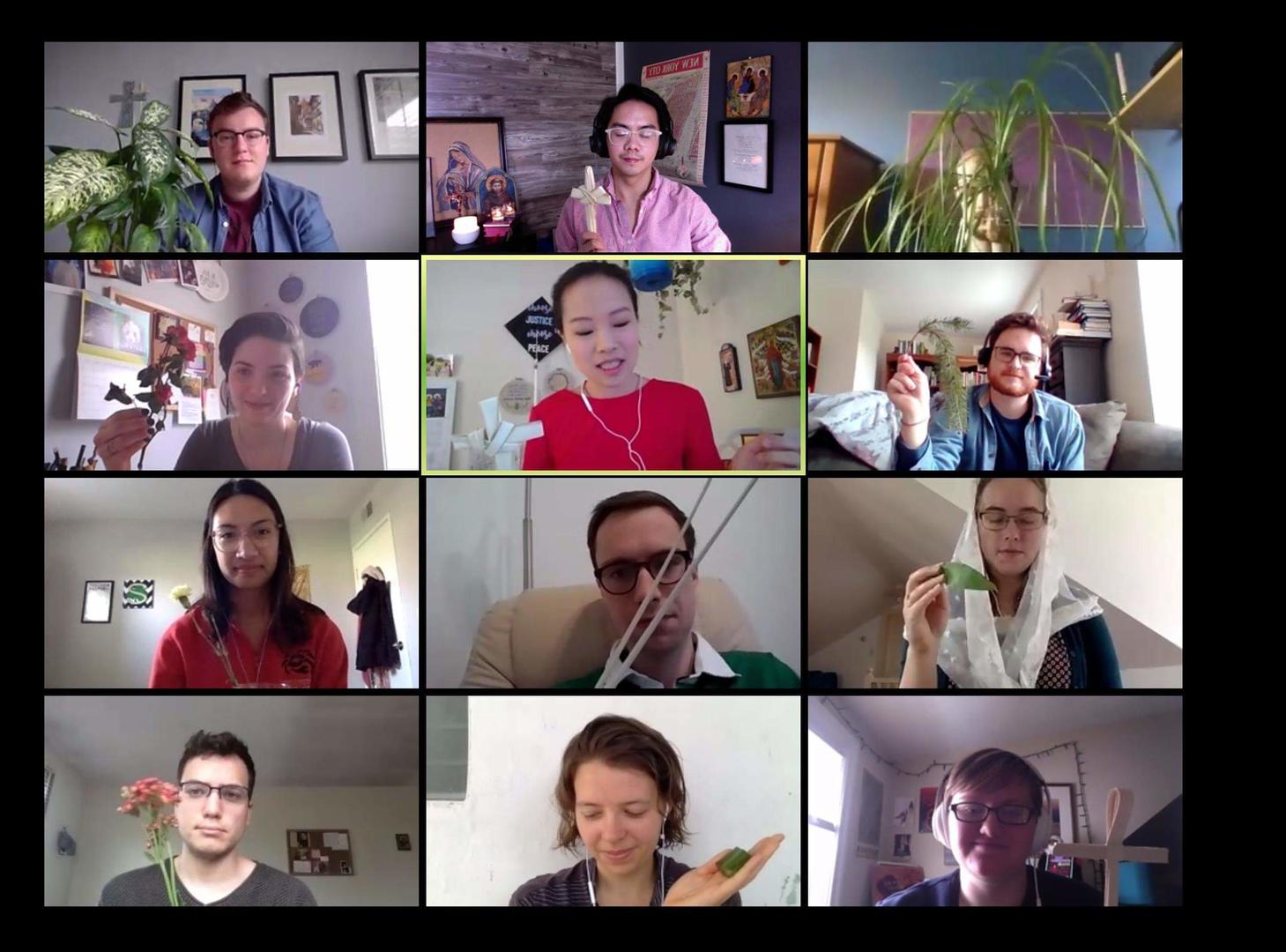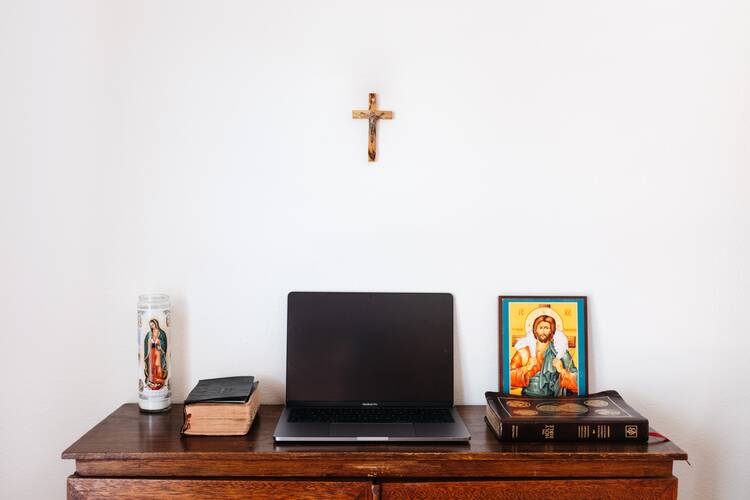The last time I “went to church,” there was no priest, no choir and no church building at all. On Friday, March 13, Cardinal Seán O’Malley suspended all public Masses in the Archdiocese of Boston. By Saturday afternoon, a fellow theology student and I had cobbled together an order of service complete with that Sunday’s readings, hymns and a reflection on the Gospel. She and I texted a few of our friends and agreed to gather in her Cambridge apartment the following morning. She presided over our Liturgy of the Word, and I preached. We planned to continue gathering in our small group until public Masses resumed. But the following week, restrictions grew stricter and half of us had moved away from the Boston area to shelter in place with family. So, instead, we met on Zoom.
Our small community has been meeting online every Sunday for our Liturgies in Dispersion (a name borrowed from the Jesuit idea of communitas ad dispersionem). Together, we finished Lent, observed the sacred Triduum and even held an Easter Vigil liturgy complete with sung Exsultet and all nine Scripture readings. Each Sunday, there are a few new faces as folks share our Zoom link with their friends. We have a dedicated cantor, rotating preachers and presiders, and even weekly “parish” announcements.
For me, this quarantine has not been marked primarily by frustration over losing the Mass. Instead, it has been marked by spiritual creativity and a renewed love for lay-led liturgy.
Apart from these Sunday gatherings, I have found myself nestling back into older habits of prayer. In quarantine, my family and I have been praying the rosary every night. With my two siblings and I living away from home before the pandemic, we have not had this routine of prayer in nearly a decade. What once felt like a chore is now an opportunity to share our individual anxieties, fears and hopes with each other.
So when I recently read about prominent U.S. Catholics bragging about attending illicit underground Masses or petitioning bishops to prematurely reopen churches, I was confused. I could understand the longing for community and sacrament, but I could not understand risking public health and the common good. I began to realize that, for me, this quarantine has not been marked primarily by frustration over losing the Mass. Instead, it has been marked by spiritual creativity and a renewed love for lay-led liturgy.
Is It Real?
A friend who attended our Easter Vigil liturgy remarked afterward, “That was really nice, but was it real?” In many ways, he asked a valid and multifaceted question: 1) Did it count for our Easter Sunday obligation? 2) Can Catholic worship look so different from a normal Sunday Mass?
Given that most U.S. Catholic dioceses have dispensed Catholics from their weekly Sunday obligation, I feel unhampered by trying to make my Sunday worship “count.” But as the theology behind the Sunday obligation teaches, Christian faith stirs up a desire to gather in community to celebrate every week. Many parishes have tried to meet this need by offering live-streamed Masses. But for some, simply watching the Mass happen from their living rooms is not enough.
Christian worship has had to respond to different cultures and situations. In our current culture of social distancing, lay-led worship is just another iteration of liturgy’s adaptability.
My community’s Sunday liturgies are different from a live-streamed Mass. We do not have a priest, and we conclude each service with an act of spiritual communion instead of the Eucharist. There is time for everyone to offer their own reflections on the Scripture readings and add their own intentions for the community to pray. These liturgies strive to enact the Second Vatican Council’s ideal of full and active participation in worship.
I spoke to John Baldovin, S.J., about whether or not these lay-led liturgies were “real.” Father Baldovin, a professor of liturgy at Boston College School of Theology and Ministry, laughed and said, “It’s not the same thing, but that doesn’t mean it isn’t real.” From the early church, he explained, “the liturgy has always been adaptive and creative.” Christian worship has had to respond to different cultures and situations. In our current culture of social distancing, lay-led worship is just another iteration of liturgy’s adaptability.
What Are the Rules?
When my friend and I prepared that first Liturgy of the Word in her apartment, we were very careful to make a distinction between what we laypeople could do and the actions reserved for priests. We did not dare think about trying to share bread and wine. She omitted all of the times a priest would say, “The Lord be with you.” We rewrote the closing blessing. Instead of saying, “May God bless you...” she prayed, “May God bless us...”
In some ways, it felt very Catholic to care about these distinctions. We honored the fact that we were gathering in less-than-ideal conditions. We also made an effort to connect our prayer to communities around the world who do not have the regular presence of clergy. At first, it felt lacking. But that lack gave way to relishing how much we could do. I teared up when we sang the Gloria for the first time on Holy Thursday. I felt consoled when another friend offered her reflections on the Road to Emmaus Gospel reading.

“This might be a good time to be somewhat liberated from our priest dependency,” Father Baldovin said. “I’m not saying we don’t need priests. But priests are not the only access we have to the Catholic faith.”
As Catholics, we do have a tendency to be overly dependent on our priests. They offer us access to the sacraments and are charged with guiding communities through life. I commend the priests who quickly met their parishioners’ needs through live-streaming, phone chains and online faith sharing groups. Yet priests are not the sole guardians of Catholicism’s rich prayer tradition.
Laypeople throughout Catholic history have led communal prayer. For example, any group of Christians can pray the rosary or the chaplet of Divine Mercy together. An alternative to a Sunday Liturgy of the Word would be the Liturgy of the Hours, a set of prayers that use the psalms, Scripture readings, hymns and intercessions. The Jesuit Post can teach you how to pray the Liturgy of the Hours, and apps like iBreviary make it easily accessible online.
Through digital liturgies, guided meditation or traditional devotions with your family, lay Catholics have an embarrassment of riches at their disposal.
Speaking of apps, Teresa Berger, professor of liturgical studies and Catholic theology at Yale Divinity School, says that there are many “intriguing spaces of freedom in the digital realm.” Ms. Berger is an expert on contemporary digital worship. She told me that lay-led, digitally mediated prayer existed long before our current pandemic, and there is already a wealth of resources for Catholics looking for new ways to pray. Platforms like Pray as You Go and Hallow offer guided Catholic meditation practices. Boston College’s Faith Feeds program offers packaged guides to help anyone facilitate faith sharing groups around different themes. IgnatianSpirituality.com offers an adaptation of the Spiritual Exercises that can be done at your own pace.
“In these extraordinary circumstances,” Ms. Berger said, “I would encourage people to find their own path toward a deeper encounter with God.” Through digital liturgies, guided meditation or traditional devotions with your family, lay Catholics have an embarrassment of riches at their disposal.
What Happens When We Go Back?
A few weeks ago, as I was preparing to preside at our Zoom liturgy, a terrifying thought came to mind: What if, after this crisis comes to an end, I don’t want to return to the parish? What if this new type of liturgy teaches me to forget about the Eucharist and focus instead on my small community?
This fear quickly went away when I joined my family for a live-streamed Mass later that day. Although I had listened to the same readings and said many of the same prayers, I still longed to sit inside the church, actively participating. I still felt hungry for the Eucharist. But rather than focus solely on my longing, I also felt more alive because of the smaller liturgy beforehand. I felt more connected to the Scripture, more acutely aware of God’s presence in my life.
Lay-led liturgies cannot be an adequate substitute for the Mass. Nothing can. But they can help move through these anxiety-ridden times.
Pope Francis responded to a similar question in a recent interview. When asked whether he thinks this crisis will produce a less institutional church, he said, “It is the Holy Spirit who institutionalizes the church...because the Holy Spirit provokes disorder through the charisms, but then out of that disorder creates harmony.” What feels like a messy and disorganized situation today can actually allow for the Holy Spirit to breathe new life into the church.
Pope Francis does not expect us to be less institutional. Instead, this church in crisis can continue to be an institution in which creativity reigns. Today, Pope Francis says, “we need an apostolic creativity, a creativity shorn of so many useless things but with a yearning to express our faith in community, as the people of God.”
As Catholics, we are tempted to treat the Eucharist like our only access to God. Yes, it is the primary and perfect way to unite with God, but it is not our only way. At its heart, Catholicism is a maximalist religion. We are wary of ideas like sola fide or sola scriptura because they reduce our faith. We hold together faith and works, Scripture and tradition. Therefore, we should be careful not to slip into a sola eucharistia mindset. Instead of thinking we are totally lost without the Mass, perhaps we can draw from our wealth of spiritual treasures. We can still worship God now while also longing to be reunited at the Mass soon.
These lay-led liturgies cannot be an adequate substitute for the Mass. Nothing can. But they can help move through these anxiety-ridden times. Churches may be beginning to reopen, but we are still a long way from normal parish life. Diving into the tradition to find practices that sustain us today does not mean we will ignore the Eucharist when it does become available to us again. Shedding some of our priest dependency in quarantine does not mean that we will turn our backs on the sacraments after quarantine. The longing for communal worship and lamenting the loss of the Eucharist will remain. Yet, as it was for the disciples after the resurrection, that grief can be mixed in with joy, creativity and the continued presence of God.









